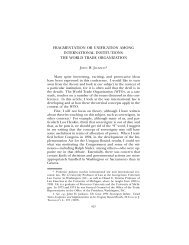some concluding remarks - Project on International Courts and ...
some concluding remarks - Project on International Courts and ...
some concluding remarks - Project on International Courts and ...
Create successful ePaper yourself
Turn your PDF publications into a flip-book with our unique Google optimized e-Paper software.
920 INTERNATIONAL LAW AND POLITICS [Vol. 31:919strive to dem<strong>on</strong>strate—in the form of variati<strong>on</strong>s <strong>on</strong> the themeof unity <strong>and</strong> diversity in law.A. Unity of Legal Thought <strong>and</strong> Diversity of Legal OrdersWhen we speak of c<strong>on</strong>tract, resp<strong>on</strong>sibility, or a judicial organ,these terms c<strong>on</strong>vey to us, whatever our legal backgrounds,a certain comm<strong>on</strong> generic idea (but I insist <strong>on</strong> “generic”).There is, then, a certain unity or comm<strong>on</strong>ality of legal thoughtam<strong>on</strong>g all the inhabitants of the legal universe. But at thesame time, there is also diversity of legal orders. It is alwaysamusing when respectable jurists, including the current Presidentof the Internati<strong>on</strong>al Court of Justice, in order to reachthe c<strong>on</strong>clusi<strong>on</strong> that private c<strong>on</strong>tracts with governments can belifted to the internati<strong>on</strong>al level, argue that they are governedby the principle of pacta sunt serv<strong>and</strong>a, which, they emphaticallyadd, is a principle of internati<strong>on</strong>al law. But pacta suntserv<strong>and</strong>a is a general principle of law existing in all legal orders.By itself, it does not tell us anything specific about theapplicable law. Such comm<strong>on</strong> c<strong>on</strong>cepts <strong>and</strong> general principlesare incarnated <strong>and</strong> managed in different ways, yieldingdifferent outcomes, in different legal orders.B. Unity of Legal Order <strong>and</strong> Diversity of TribunalsEvery legal order has its own fr<strong>on</strong>tiers that separate itfrom other legal orders, because it has a different basis of legitimacy<strong>and</strong> different mechanisms for creating, applying, <strong>and</strong>enforcing its rules. In other words, every legal order generates<strong>and</strong> specifies its rules in different ways, with different results,<strong>and</strong> these rules <strong>and</strong> procedures ultimately derive their legitimacyfrom the fact of bel<strong>on</strong>ging to this legal order. It c<strong>on</strong>stitutesa unicum: an entity held together by its own internal cohesiveforces, while remaining separate <strong>and</strong> distinguishablefrom other legal orders. Yet within each legal order (except,perhaps, for the very primitive <strong>on</strong>es, which can be assimilatedto unicellular living organisms), there exists a multitude of organscharged with the implementati<strong>on</strong> <strong>and</strong> applicati<strong>on</strong> of law,including a diversity of courts <strong>and</strong> tribunals (the type <strong>and</strong>number of which differing from <strong>on</strong>e legal order to another).






